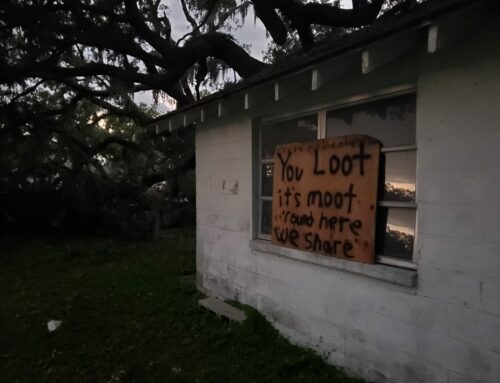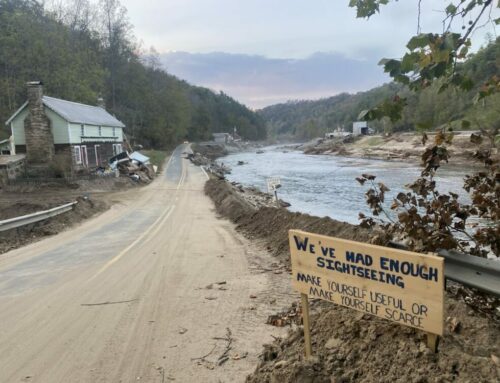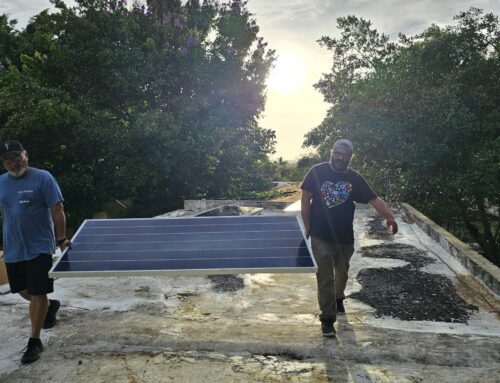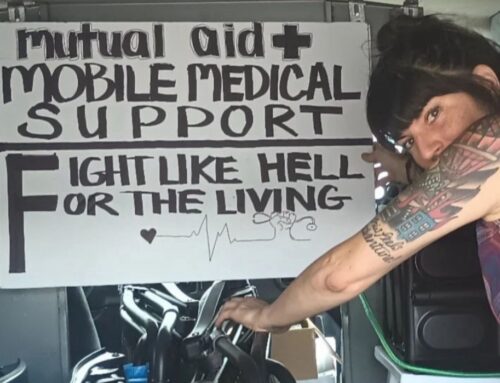
“We Keep each Other Safe” by Monica Trinidad
While grieving the loss all around us, we’re simultaneously finding fortitude in a world suddenly in bloom with thousands upon thousands of mutual aid-based projects, ideas, and connections. We’ve seen so many inspiring resource lists sharing the logistics of how to respond to COVID19 with mutual aid; how to get neighbors in touch, start food distribution programs, and organize rent strikes.
We want to encourage people new to mutual aid-based organizing to not limit their understanding of the concept as merely the growth, gathering, and sharing of fruits with our neighbors. Although this is amazing and beautiful in itself, for our mutual aid work to be meaningful in its capacity to increase community power and sustainable in its ability to withstand what will inevitably challenge it, our efforts need strong roots. We need to grow intertwined with each other and deeply connected to the old growth that came before this crisis and to visions of the world we’re growing towards. We need to develop these roots with conscious intention and care.
In this post, we’re sharing reflections, inspiration, and resources to contextualize our current efforts beyond the COVID19 crisis while nourishing deeper understandings of what it means for this work to be deeply rooted in mutual aid’s fertile soil.
If you have something you’d like to see added to this resource list, shoot us an email at [email protected].
REFLECTIONS
A few reflections on what mutual aid means in the context of our liberatory work:
- Mutual aid is a natural way that we respond to crisis and part of our natural state as humans, but a long history of colonization and capitalization has intentionally calloused us and clouded our ability to take care of each other on a daily basis. We have a lot of hard work to do to decolonize ourselves and weed out the racism, classism, patriarchy, homophobia, and transphobia that have divided us from our natural desire to care for one another.
- Mutual aid must be an act of resistance. Our ability to take care of one another is a threat to the dominant systems’ need for dependence for its existence. It’s one thing to help your neighbor out on a short-term basis. It’s another to create and defend a world based on this principle. As many historical examples prove, powerful mutual aid projects may eventually be sabotaged or co-opted by those seeking to maintain control; that includes the State, the capitalists, and the non-profit industrial complex. In the COVID19 crisis, we’re also watching politicians and the mainstream take up the term “mutual aid” without mentioning how they contribute to a system that necessitates our having to defend its practice.For now our mutual aid work is likely of service to those in power as they lack the ability to maintain control themselves. But during this time, we can’t just aim to build community, but to build community that is oriented in conscious opposition to the systems of authority that will come after us when they’ve regained their footing.
- Mutual aid is not a new fad, and we all have a lot to learn from long-oppressed communities who often have far more lived experience with the concept in practice than settlers do; it is how these communities have survived for hundreds of years of colonization. It is incredibly misguided to try rolling out a hot new mutual aid project in an oppressed community without listening and seeking to learn from that community’s experience and wisdom.
- Mutual aid is different from charity in that it strives to deconstruct the hierarchical relationships we are so in the habit of acting through. It is a multidimensional and multidirectional process that contributes to the liberation of everyone involved. We must create communities that can organize themselves, collaborate on projects, and build alternatives horizontally. Mutual aid opens up pathways for people to engage in meaningful, authentic participation even if they also are receiving assistance. This deconstruction of hierarchy is challenging. It requires us to be vulnerable and curious about the way we’re approaching our work. It requires trust building.
- It’s not enough to just say a group is a horizontally organized, mutual aid-based group. We have to take time and energy to develop our principles, learn about and critique what they mean in practice, share them with newcomers, and build a collective vision for the world we’re creating. Mutual aid, horizontality, and solidarity are abstract concepts that can be difficult to actualize; we often don’t have many examples on hand to draw from, and they can look different for every community. This principle and vision building can be difficult to prioritize in crisis because it feels like you’re trading off energy that could otherwise be spent meeting people’s unmet survival needs. But this is essential work for matching what we preach with what we are actually building.
- We must be planning to sustain our mutual aid work for the long-haul. Our communities will be in need for a very long time after this pandemic passes, and some of the most important work we have to do is still ahead. Meaningful, rooted community can take time and patience to develop the trust and accountability necessary. We must create cultures of sustainability and self and collective care and rotate roles and responsibilities when possible so that we can tap in and out for each other.
INSPIRATION
A handful of inspiring ideas we’re hearing groups implementing in their new projects and communities:
- Forming points of unity/guiding principles for a group and holding virtual introductory meetings for new volunteers to discuss them and what they want them to look like in practice. Setting up regular virtual meetings and webinars for neighborhood blocks to explore the concepts of mutual aid, horizontality, and solidarity. Holding reading groups, hosting people experienced with consensus decision making, breaking down the problems with hierarchical structures and habits, brainstorming about the world a community wants to create and the threats to that new world.
- Building culture by example by starting meetings with: Capacity check-ins, timed discussion on how people are experiencing any power dynamics, prompts for brainstorming what burnout means to people and how they’re coping, prompts for exploring what connections people are excited about, things they’ve realized that week, what’s been uplifting for them.
- Communizing funds where possible to purchase community infrastructure.
- Building up the commons and the vision of our new world by sharing art and propaganda in public spaces: Banner drops in neighborhoods, sheets being hung to signify those rent striking, subversive signs being hung in people’s windows and on telephone poles, murals being painted, car noise demos being coordinated.
- As an alternative to taking on the labor of finding ways new volunteers can plug in when they ask “How can I help?”, encouraging the development of their autonomy by asking them “How do you want to help? What are your skills and interests?” (This zine on identifying skills is handy too.)
RESOURCES
Some resources that may help you and your community develop your roots in mutual aid:
On what mutual aid is:
- Submedia’s: What Is Mutual Aid? (video)
- Peter Kropotkin’s Mutual Aid: A Factor of Evolution (book)
- Big Door Brigade’s: What is Mutual Aid? (video, definitions, and resources)
- What do we mean by “mutual aid”? (handout)
- What is Mutual Aid? (video)
- We Are Plan C Self-Education Module: WTF is Mutual Aid? (resources)
- Highlander Center: The History and Principles of Mutual Aid (webinar)
- Mutual Aid: Building Solidarity During This Crisis and the Next (book)
- The Strategy of Mutual Aid (video)
Examples of powerful mutual aid projects in history:
- The Other Occupy Oakland: Lessons from Depression Era Mutual Aid (article)
- 8 Black Panther Party Programs That Were More Empowering Than Federal Government Programs (article)
- Dual Power Then And Now: From the Iroquois to Cooperation Jackson (article)
- Paradise Built in Hell (book)
- Mutual Aid Dispatches (article)
- Reading Questions from Dean Spade’s Queer and Trans Mutual Aid for Survival and Mobilization Class (teaching syllabus)
- COVID-19, Resource Colonialism, and Indigenous Resistance (article)
Lessons learned organizing mutual aid projects:
- Mutual Aid Disaster Relief’s Lessons Learned. (zine)
- A Window Propped Open: Lessons Learned Organizing After Hurricane Harvey (zine)
- A Window Propped Open: Reflections Responding to Hurricane Harvey (zine)
- A Window Propped Open III: Reflections on Two Years of Harvey Recovery Work (zine)
Resources for building community and groups:
- Netlab’s Organizing for Justice Amidst Crisis (worksheets and other tools)
- Organizational Culture Chart (chart and reflections)
- Leadership Qualities That Support Mutuality and Collaboration (chart)
- Table for Identifying Potential Constructive Programs (worksheet)
- Leading Groups Online (ebook)
Principles to guide our work:
